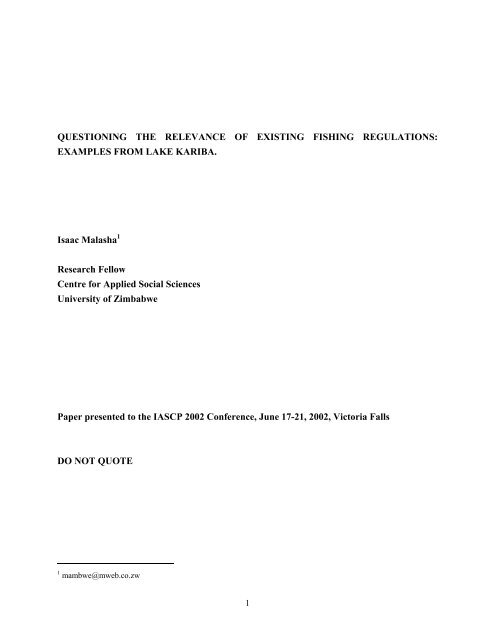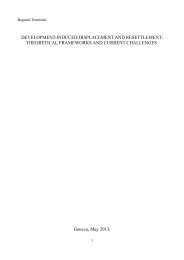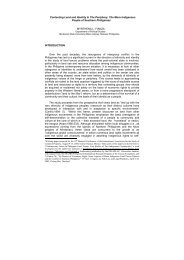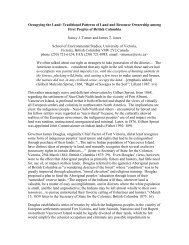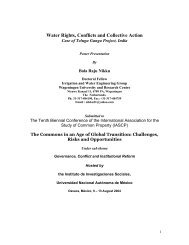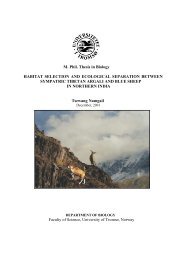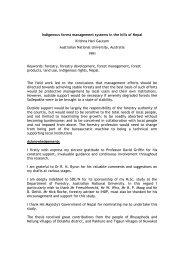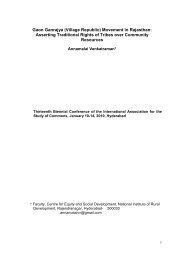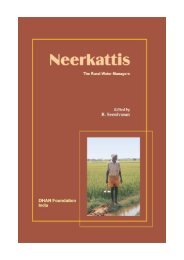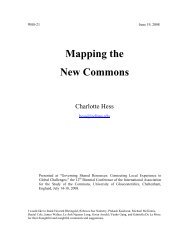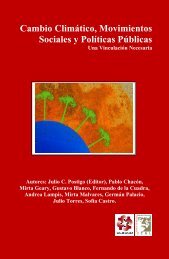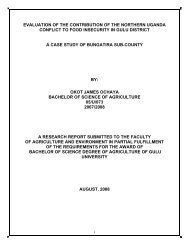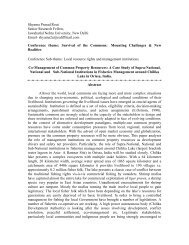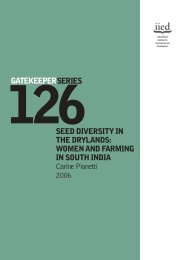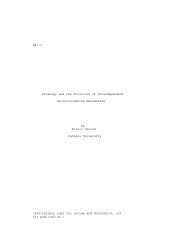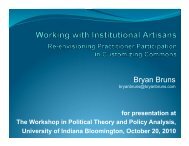The emergence of fisheries legislation and regulations in Zambia ...
The emergence of fisheries legislation and regulations in Zambia ...
The emergence of fisheries legislation and regulations in Zambia ...
Create successful ePaper yourself
Turn your PDF publications into a flip-book with our unique Google optimized e-Paper software.
QUESTIONING THE RELEVANCE OF EXISTING FISHING REGULATIONS:<br />
EXAMPLES FROM LAKE KARIBA.<br />
Isaac Malasha 1<br />
Research Fellow<br />
Centre for Applied Social Sciences<br />
University <strong>of</strong> Zimbabwe<br />
Paper presented to the IASCP 2002 Conference, June 17-21, 2002, Victoria Falls<br />
DO NOT QUOTE<br />
1 mambwe@mweb.co.zw<br />
1
Introduction<br />
Fisheries management <strong>and</strong> the <strong>regulations</strong> on which it is based have ma<strong>in</strong>ly been premised on the<br />
values <strong>of</strong> positivistic science with its strong emphasis on rationality <strong>and</strong> impartiality. Positivistic<br />
science tend to portray the universe as mechanistic <strong>and</strong> determ<strong>in</strong>istic <strong>and</strong> its work<strong>in</strong>gs as be<strong>in</strong>g<br />
governed by a few fundamental <strong>and</strong> unvary<strong>in</strong>g laws. Based on these laws scientists can derive<br />
<strong>regulations</strong> that <strong>in</strong>form the manner <strong>in</strong> which a particular natural resource such as fish should be<br />
exploited to ensure the susta<strong>in</strong>ability <strong>of</strong> the stocks. However, the implementation <strong>and</strong><br />
enforcement <strong>of</strong> these <strong>regulations</strong> have to fit <strong>in</strong>to the political <strong>and</strong> economic rationality <strong>of</strong> a state<br />
<strong>in</strong> which they emerge <strong>and</strong> these rationalities may be at variance with those <strong>of</strong> science. <strong>The</strong><br />
purpose <strong>of</strong> this paper is to explore the reasons for the type <strong>of</strong> <strong>fisheries</strong> <strong>regulations</strong> that emerged <strong>in</strong><br />
<strong>Zambia</strong> <strong>and</strong> Zimbabwe. It will be shown that although there were attempts to justify the<br />
<strong>regulations</strong> with reference to scientific pr<strong>in</strong>ciples, the <strong>regulations</strong> had to fit the political <strong>and</strong><br />
economic <strong>in</strong>terests <strong>of</strong> their respective states as well as they reflected the dom<strong>in</strong>at<strong>in</strong>g<br />
representations <strong>and</strong> images <strong>of</strong> the man-nature relationship that prevailed among the agents <strong>of</strong> the<br />
states. This resulted <strong>in</strong> conflicts between fishermen <strong>and</strong> government agents <strong>and</strong> ambiguity <strong>in</strong><br />
implement<strong>in</strong>g the <strong>regulations</strong>. Us<strong>in</strong>g examples from Lake Kariba the paper shows how efforts to<br />
develop uniform fish<strong>in</strong>g <strong>regulations</strong> for the fishery <strong>of</strong> the man-made lake were not successful<br />
because <strong>of</strong> fundamentally different state <strong>in</strong>terests towards fish <strong>and</strong> <strong>fisheries</strong> <strong>in</strong> the two countries.<br />
<strong>The</strong> management <strong>of</strong> fish as game<br />
One <strong>of</strong> the most noticeable relationships between game <strong>and</strong> <strong>fisheries</strong> is the manner <strong>in</strong> which these<br />
resources have been managed especially <strong>in</strong> a southern African context. In most African countries<br />
game <strong>and</strong> <strong>fisheries</strong> have been managed under the same bureaucratic <strong>in</strong>stitution. But much more<br />
fundamentally is the similarity <strong>in</strong> the <strong>regulations</strong> def<strong>in</strong><strong>in</strong>g the way <strong>in</strong> which they are accessed <strong>and</strong><br />
utilised. <strong>The</strong> scientific arguments that had been used to develop game laws were transferred to<br />
the way the <strong>fisheries</strong> sector would be regulated. Consequently, <strong>fisheries</strong> <strong>regulations</strong> emerged as<br />
an adjunct <strong>of</strong> the Game Laws. From 1925 the <strong>fisheries</strong> sector <strong>in</strong> <strong>Zambia</strong> was managed under<br />
various Game Laws until 1943 when the Fish Control Regulations Act was enacted. Similarly, <strong>in</strong><br />
Zimbabwe the Game Laws that were <strong>in</strong>troduced <strong>in</strong> 1891 were also applicable to fish until 1938<br />
when a section specifically deal<strong>in</strong>g with <strong>fisheries</strong> was <strong>in</strong>corporated <strong>in</strong>to the Game <strong>and</strong> Fish<br />
Amendment Act. In these various acts a fish was classified as an ‘animal’ <strong>and</strong> fish<strong>in</strong>g was<br />
perceived to be another form <strong>of</strong> ‘hunt<strong>in</strong>g.’ 2<br />
2 <strong>Zambia</strong> National Archives (ZNA), Ref. No. ML 1/7/19, Vaughan Jones, `Prelim<strong>in</strong>ary Report on the Fish<strong>in</strong>g<br />
Industry <strong>and</strong> Its Markets, 1942 .<br />
2
Hunt<strong>in</strong>g restrictions that are a common feature <strong>of</strong> game <strong>legislation</strong> were applied to <strong>fisheries</strong>.<br />
Restrictions through various means such as closed seasons <strong>and</strong> licens<strong>in</strong>g are meant to allow for<br />
selective removal <strong>of</strong> certa<strong>in</strong> specimen at particular times to avoid over-hunt<strong>in</strong>g. When extended<br />
to fish<strong>in</strong>g it is argued that closed seasons <strong>and</strong> licences are necessary because they limit the<br />
amount <strong>of</strong> fish to be harvested thereby prevent<strong>in</strong>g the depletion <strong>of</strong> fish resources (Jackson 1961).<br />
Another aspect <strong>of</strong> game laws that were transferred to the way fish was to be regulated is related<br />
to the protection <strong>of</strong> young specimen. This measure was meant to avoid the kill<strong>in</strong>g <strong>of</strong> young<br />
specimens as this would eventually lead to the ext<strong>in</strong>ction <strong>of</strong> a given species. It was necessary to<br />
only allow for the hunt<strong>in</strong>g <strong>of</strong> animals that had reached such an age that their removal would not<br />
have an impact on the ability <strong>of</strong> the rema<strong>in</strong><strong>in</strong>g specimens from replenish<strong>in</strong>g themselves. This<br />
<strong>legislation</strong> is comprehensible <strong>in</strong> that most game, especially those that the laws sought to protect,<br />
such as e.g. elephants, do not reproduce rapidly <strong>and</strong> <strong>in</strong> large numbers. Thus, when specific<br />
fish<strong>in</strong>g <strong>regulations</strong> began to emerge <strong>in</strong> <strong>Zambia</strong> <strong>and</strong> Zimbabwe there was emphasis on sett<strong>in</strong>g<br />
m<strong>in</strong>imum mesh sizes <strong>of</strong> fish<strong>in</strong>g nets <strong>and</strong> the admissible width <strong>of</strong> apertures <strong>in</strong> fish<strong>in</strong>g traps <strong>and</strong><br />
baskets. <strong>The</strong>se clauses on m<strong>in</strong>imum mesh-sizes were aimed at prevent<strong>in</strong>g the harvest<strong>in</strong>g <strong>of</strong><br />
f<strong>in</strong>gerl<strong>in</strong>gs. Other fish<strong>in</strong>g gear such as weirs were legislated aga<strong>in</strong>st because they were<br />
considered to be successful only if the fish move, <strong>and</strong> a fish moves, nearly always, under the<br />
impulse <strong>of</strong> its spawn<strong>in</strong>g migration (Jackson1961).<br />
Ideological reasons were also beh<strong>in</strong>d some <strong>of</strong> the <strong>regulations</strong> that emerged. As <strong>legislation</strong> for the<br />
conservation <strong>of</strong> game was emerg<strong>in</strong>g calls were made to proscribe certa<strong>in</strong> hunt<strong>in</strong>g methods<br />
considered to be ‘unfair’ to the hunted animal (Be<strong>in</strong>art <strong>and</strong> Coates 1995). This was advanced<br />
<strong>in</strong>to the public doma<strong>in</strong> as the element <strong>of</strong> ‘sport’ <strong>in</strong> game management began to be pushed to the<br />
top <strong>of</strong> the conservation agenda. 3 When hunt<strong>in</strong>g game, an animal had to be given an opportunity<br />
<strong>of</strong> escap<strong>in</strong>g <strong>in</strong> the spirit <strong>of</strong> ‘fair play.’ Hunt<strong>in</strong>g methods considered as not giv<strong>in</strong>g hunted game a<br />
chance to escape were considered ‘unsportman-like’ <strong>and</strong> prohibited. For <strong>in</strong>stance, Section 33 <strong>of</strong><br />
the Game Ord<strong>in</strong>ance <strong>of</strong> 1941 specified that no person shall drive, stampede or unduly disturb any<br />
animal when hunt<strong>in</strong>g. This “fair chance” approach to the hunt<strong>in</strong>g <strong>of</strong> game proved to have<br />
considerable impact on formulation <strong>of</strong> <strong>fisheries</strong> <strong>regulations</strong>. 4 When new <strong>legislation</strong> on fish<strong>in</strong>g<br />
3 Accord<strong>in</strong>g to Mackenzie (1987: 22-40) hunters also anthropomorphised animals <strong>in</strong> attempt to suggest a degree <strong>of</strong><br />
equality <strong>in</strong> the contest <strong>and</strong> therefore emphasise the physical endurance <strong>and</strong> courage required <strong>in</strong> the Hunt. Thus, the<br />
kill<strong>in</strong>g <strong>of</strong> <strong>in</strong>telligent animals such as the elephant provided the greatest exhilaration.<br />
4 <strong>The</strong> classification <strong>of</strong> hunt<strong>in</strong>g between ‘good’ <strong>and</strong> ‘bad’ hunt<strong>in</strong>g methods was aimed at outlaw<strong>in</strong>g the latter<br />
methods. <strong>The</strong> use <strong>of</strong> traps, baskets <strong>and</strong> nets, which had been predom<strong>in</strong>antly the preserve <strong>of</strong> Africans, were<br />
proscribed <strong>in</strong> the new pieces <strong>of</strong> <strong>regulations</strong>. <strong>The</strong> accepted methods were basically modelled on Anglo-Saxon notions<br />
3
was drawn-up <strong>in</strong> 1943 <strong>in</strong> <strong>Zambia</strong>, active fish<strong>in</strong>g or kutumpula as it is locally known, was banned.<br />
This fish<strong>in</strong>g method <strong>of</strong> driv<strong>in</strong>g fish <strong>in</strong>to nets by splash<strong>in</strong>g <strong>and</strong> beat<strong>in</strong>g <strong>of</strong> paddles was considered<br />
to be <strong>in</strong>tr<strong>in</strong>sically harmful as it operates <strong>in</strong> shallow <strong>and</strong> weedy areas where the fish go to breed. 5<br />
However, these scientific <strong>and</strong> ideological justifications mask the economic <strong>and</strong> political <strong>in</strong>terests<br />
that they <strong>in</strong>tended to achieve. Dom<strong>in</strong>ant groups <strong>in</strong> society used these justifications to advance<br />
their economic <strong>and</strong> political <strong>in</strong>terests <strong>in</strong> the way people accessed <strong>and</strong> utilised natural resources.<br />
For <strong>in</strong>stance, while the need to licence a fisherman is scientifically sound as it controls entry to<br />
the resource it, nevertheless, conceals the social, political <strong>and</strong> economic role <strong>of</strong> fish<strong>in</strong>g licences<br />
<strong>in</strong> subsidis<strong>in</strong>g colonial rule. In most British colonies local adm<strong>in</strong>istrative structures <strong>in</strong> rural areas<br />
known as Native Authorities issued licences to fishermen. <strong>The</strong> revenue raised was used to pay<br />
the salaries <strong>of</strong> chiefs <strong>and</strong> other employees <strong>of</strong> the authorities. Gordon (2000) notes that <strong>in</strong> 1943<br />
chiefs <strong>in</strong> the <strong>fisheries</strong> <strong>in</strong> northern <strong>Zambia</strong> were eager to enforce fish<strong>in</strong>g <strong>regulations</strong> because they<br />
benefited from the fish-licens<strong>in</strong>g system. For <strong>in</strong>stance, the Shila <strong>and</strong> Chish<strong>in</strong>ga Native Authorities<br />
from these <strong>fisheries</strong> derived most <strong>of</strong> their <strong>in</strong>come from this fish levy.<br />
Emergence <strong>of</strong> <strong>fisheries</strong> <strong>legislation</strong> <strong>in</strong> <strong>Zambia</strong><br />
It was only after 1940 that efforts to develop a local policy for the conservation <strong>of</strong> fish were<br />
made <strong>in</strong> <strong>Zambia</strong>. Firstly, while fish<strong>in</strong>g had been a source <strong>of</strong> food <strong>and</strong> employment, even before<br />
the colonial period, it was now discovered that it would benefit the economy more if some<br />
measures were implemented to control the <strong>in</strong>dustry. This was based on the prevalence <strong>of</strong><br />
numerous water bodies that were estimated to have produced fish worth more than one<br />
hundred <strong>and</strong> fifty thous<strong>and</strong> British Pounds per annum. 6 Secondly, the need to support the<br />
boom<strong>in</strong>g copper <strong>in</strong>dustry with the provision <strong>of</strong> cheap food prompted the authorities to beg<strong>in</strong> to<br />
draw <strong>fisheries</strong> <strong>legislation</strong>. Although beef had <strong>in</strong>itially been used to feed the labour on the<br />
m<strong>in</strong>es, problems associated with supplies that occurred <strong>in</strong> the early 1940’s, prompted the<br />
authorities <strong>and</strong> m<strong>in</strong>e owners to beg<strong>in</strong> to explore alternative sources <strong>of</strong> cheap food supplies for<br />
<strong>of</strong> ‘good’ hunt<strong>in</strong>g afford<strong>in</strong>g a hunted prey a ‘fair chance’. Accord<strong>in</strong>g to Be<strong>in</strong>art <strong>and</strong> Coates (1995: 28), this crusade<br />
<strong>of</strong> outlaw<strong>in</strong>g local hunt<strong>in</strong>g methods gave rise to the <strong>emergence</strong> <strong>of</strong> various conservation oriented groups such as the<br />
Royal Society for the Protection <strong>of</strong> Birds whose ma<strong>in</strong> concern was to fight aga<strong>in</strong>st the plumage trade. Such groups<br />
emerged <strong>in</strong> the colonies as well.<br />
5 Although Kutumpula was frowned upon as a fish<strong>in</strong>g method, the authorities were sometimes forced to ignore this<br />
fish<strong>in</strong>g method due to the resistance <strong>of</strong> local fishermen. For <strong>in</strong>stance, the Fish Control (Mweru-Luapula) Fish<strong>in</strong>g<br />
Regulations specifically noted that Kutumpula was to be authorised. (ZNA, Ref. No. ML 1/7/18, Correspondence<br />
from District Commissioner, Kawambwa to Director <strong>of</strong> Game <strong>and</strong> Tsetse Control, 1949.)<br />
6 ZNA Ref. No. Sec 6/190, Correspondence from Act<strong>in</strong>g Director <strong>of</strong> Game <strong>and</strong> Tsetse Control to Secretary to<br />
Cab<strong>in</strong>et, 1943.<br />
4
labour. Gordon (2000) observes that severe beef shortages that occurred <strong>in</strong> 1941, 1943 <strong>and</strong><br />
later <strong>in</strong> 1948 compelled m<strong>in</strong>e owners to import five hundred tons <strong>of</strong> fish from a Congolese<br />
supplier to pacify the restless workers. Dur<strong>in</strong>g these food shortages prices went up caus<strong>in</strong>g<br />
<strong>in</strong>stability <strong>in</strong> the urban areas. This compelled the authorities to impose price controls as a<br />
short-term measure. <strong>The</strong> Prov<strong>in</strong>cial Commissioner (PC) responsible for the Copperbelt<br />
implored the Director responsible for the <strong>fisheries</strong> sector to maximise fish production by also<br />
suspend<strong>in</strong>g the exist<strong>in</strong>g fish<strong>in</strong>g <strong>regulations</strong> that were still under the Game Ord<strong>in</strong>ance Act <strong>of</strong><br />
1941. <strong>The</strong> strict enforcement <strong>of</strong> the <strong>regulations</strong> was seen as contribut<strong>in</strong>g to the shortage <strong>of</strong> fish<br />
on the Copperbelt. <strong>The</strong> PC argued that:<br />
“We are hav<strong>in</strong>g some difficulty <strong>in</strong> keep<strong>in</strong>g our workers contended here ow<strong>in</strong>g to short supplies.<br />
<strong>The</strong> po<strong>in</strong>t may be reached when discontent will have serious repercussions on copper production,<br />
which would be more disastrous even than upsett<strong>in</strong>g the <strong>in</strong>ternal economy <strong>of</strong> Northern Prov<strong>in</strong>ce<br />
or deplet<strong>in</strong>g its fish supplies for a time. Bangweulu fish supplies have some bear<strong>in</strong>g on copper<br />
production.” 7<br />
This statement is evident <strong>of</strong> the importance with which copper production was l<strong>in</strong>ked to the<br />
availability <strong>of</strong> cheap food for the labour. Although the fish<strong>in</strong>g <strong>regulations</strong> had been implemented<br />
to protect the fish<strong>in</strong>g <strong>in</strong>dustry, these were now seen as h<strong>in</strong>der<strong>in</strong>g copper production. To the state,<br />
the collapse <strong>of</strong> the fish<strong>in</strong>g <strong>in</strong>dustry was not as paramount as long as copper production was<br />
susta<strong>in</strong>ed. <strong>The</strong> Director <strong>of</strong> Game <strong>and</strong> Tsetse Control concurred with the Prov<strong>in</strong>cial Commissioner<br />
by observ<strong>in</strong>g that ‘the importance <strong>of</strong> ma<strong>in</strong>ta<strong>in</strong><strong>in</strong>g a smooth atmosphere on the Copperbelt was so<br />
great that fish supplies should be given a high importance relative to that <strong>of</strong> oppos<strong>in</strong>g factors.’<br />
Consequently, fish<strong>in</strong>g <strong>regulations</strong> were relaxed <strong>and</strong> the supply <strong>of</strong> fish to the Copperbelt<br />
improved. 8 Follow<strong>in</strong>g other food shortages that occurred on the Copperbelt <strong>in</strong> 1943 the<br />
authorities responded by <strong>in</strong>vok<strong>in</strong>g Emergency Powers (Control <strong>of</strong> Fish) Regulations. <strong>The</strong>se<br />
emergency measures were designed to control the distribution <strong>of</strong> food, especially fish. 9 <strong>The</strong>se<br />
7 ZNA, Ref. No. Sec 6/190, Correspondence from Prov<strong>in</strong>cial Commissioner, Western Prov<strong>in</strong>ce to Director <strong>of</strong> Game<br />
<strong>and</strong> Tsetse Control 1943 .<br />
8 Although fish supplies temporarily improved follow<strong>in</strong>g the suspension <strong>of</strong> the fish<strong>in</strong>g <strong>regulations</strong>, the fish-price controls<br />
that were also imposed at the same time merely drove fish from the formal <strong>in</strong>to the parallel market.<br />
9 Accord<strong>in</strong>g to the Prov<strong>in</strong>cial Commissioner <strong>in</strong> charge <strong>of</strong> the Copperbelt, which was then known as the Western<br />
Prov<strong>in</strong>ce, beg<strong>in</strong>n<strong>in</strong>g <strong>in</strong> 1943 there was a shortage <strong>of</strong> various commodities on the Copperbelt, <strong>in</strong>clud<strong>in</strong>g foodstuffs.<br />
<strong>The</strong> consequence <strong>of</strong> these shortages was that fish prices went up <strong>and</strong> controls were <strong>in</strong>troduced. However, this only<br />
5
egulations gave the Director <strong>of</strong> Game <strong>and</strong> Tsetse Control a wide range <strong>of</strong> powers to deal with<br />
the distribution <strong>of</strong> fish by prohibit<strong>in</strong>g the importation or export <strong>of</strong> fish <strong>in</strong>to or from any Fishery<br />
Area. 10 <strong>The</strong>y further empowered the Director to make limitations on weight <strong>of</strong> fish or the market<br />
<strong>in</strong> which it was supposed to be sold. <strong>The</strong>se controls were only abolished <strong>in</strong> 1946 when the<br />
distribution <strong>of</strong> fish improved. 11<br />
Ambiguity <strong>in</strong> the application <strong>of</strong> <strong>fisheries</strong> <strong>regulations</strong><br />
Because <strong>of</strong> the diverse manner <strong>in</strong> which <strong>fisheries</strong> <strong>regulations</strong> had emerged <strong>and</strong> were implemented<br />
there was bound to be ambiguity <strong>and</strong> resentment <strong>in</strong> their application. This was also compounded<br />
by the fact that <strong>The</strong> Department <strong>of</strong> Game <strong>and</strong> Tsetse Control, under which fish was managed, did<br />
not have adequate staff to implement the fish<strong>in</strong>g <strong>regulations</strong>. In some <strong>of</strong> the <strong>fisheries</strong> <strong>in</strong> remote<br />
areas it was left to the District Commissioners <strong>and</strong> other colonial <strong>of</strong>ficers act<strong>in</strong>g on basis <strong>of</strong> their<br />
own (sometimes preconceived) assumptions <strong>of</strong> <strong>fisheries</strong> management to enforce the fish<strong>in</strong>g<br />
<strong>regulations</strong>. <strong>The</strong> issu<strong>in</strong>g <strong>of</strong> fish<strong>in</strong>g licences was particularly problematic. Native Authorities<br />
issued licences to fishermen who fished from water bodies under their jurisdiction. However,<br />
local fishermen could migrate from one fishery to another for different reasons. This movement<br />
<strong>of</strong> fishermen across boundaries proved to be a problem <strong>in</strong> some Native Authorities as it deprived<br />
them <strong>of</strong> much needed revenue<br />
<strong>The</strong> enforcement <strong>of</strong> m<strong>in</strong>imum net mesh-sizes <strong>and</strong> types <strong>of</strong> nets to be used were also a contentious<br />
issue between the authorities <strong>and</strong> fishermen. <strong>The</strong> m<strong>in</strong>imum mesh sizes were designed to ensure<br />
that all the fish caught <strong>in</strong> a net were bigger <strong>and</strong> would have bred once. This regulation ignored<br />
the fact that some fish species could reach their maximum size without be<strong>in</strong>g caught <strong>in</strong> the<br />
m<strong>in</strong>imum allowed mesh-sizes. In 1949, fishermen <strong>in</strong> Kasempa <strong>in</strong> the north-western part <strong>of</strong> the<br />
country compla<strong>in</strong>ed that the <strong>in</strong>stitution <strong>of</strong> m<strong>in</strong>imum mesh-size for their fish<strong>in</strong>g nets caused them<br />
to lose many fish. 12 <strong>The</strong>y argued that the fish species that they particularly targeted were so<br />
led to drive fish <strong>of</strong>f the <strong>of</strong>ficial market <strong>in</strong>to the parallel market where prices were high (ZNA, Ref. No. 6/190,<br />
1/8/1943).<br />
10 A Fishery Area was a fishery covered by the Fish Control Regulations.<br />
11 It was dur<strong>in</strong>g this period that the Director <strong>of</strong> Game <strong>and</strong> Tsetse recommended that fish exports to Zimbabwe be banned.<br />
This ban affected the urban population <strong>in</strong> Zimbabwe that was reliant on fish supplies from <strong>Zambia</strong>. <strong>The</strong>se fish- exports<br />
had amounted to about 5000 kg’s <strong>in</strong> 1943. However, the ban on fish-exports did not stop <strong>Zambia</strong>n fish-traders from<br />
smuggl<strong>in</strong>g large quantities <strong>of</strong> fish <strong>in</strong>to that country. (ZNA, Ref. No. Sec 6/190, Correspondence from Prov<strong>in</strong>cial<br />
Commissioner to Chief Secretary, 1944.).<br />
12 ZNA, Ref. No. SEC 6/570, Act<strong>in</strong>g Director <strong>of</strong> Game <strong>and</strong> Tsetse Control, `Prelim<strong>in</strong>ary Report on the Fish<strong>in</strong>g<br />
Industry <strong>and</strong> its Markets, 21/10/1949.<br />
6
small even at maturity as not to be captured <strong>in</strong> the nets that they were legally allowed to use. <strong>The</strong><br />
District Commissioner disputed this argument by observ<strong>in</strong>g that the fish that was not caught <strong>in</strong><br />
the legally allowed nets was not <strong>of</strong> economic value <strong>and</strong> did not warrant the change <strong>of</strong> the mesh-<br />
size <strong>regulations</strong>. In 1953, a Fisheries Officer <strong>in</strong> Kawambwa reported that he was unable to<br />
enforce the mesh-size <strong>regulations</strong> due to resistance by local fishermen. He compla<strong>in</strong>ed that the<br />
mesh system <strong>in</strong> the <strong>fisheries</strong> under his jurisdiction was farcical due to non-observance <strong>of</strong> the<br />
<strong>regulations</strong> by the local fishermen. He recommended that fish<strong>in</strong>g <strong>regulations</strong> should no longer<br />
apply <strong>in</strong> that fishery. 13 In another example, <strong>in</strong> 1954 it was agreed that due to resistance by local<br />
fishermen <strong>and</strong> the lack <strong>of</strong> adequate personnel, fish conservation <strong>regulations</strong> <strong>in</strong> the Northern<br />
Prov<strong>in</strong>ce be ab<strong>and</strong>oned <strong>in</strong> all but the follow<strong>in</strong>g <strong>fisheries</strong>; Mweru-Luapula; Mweru-wa-Ntipa;<br />
Lake Tanganyika <strong>and</strong> Bangweulu-Luapula. 14 <strong>The</strong> <strong>regulations</strong> were relaxed but despite the<br />
ab<strong>and</strong>onment or suspension <strong>of</strong> all or certa<strong>in</strong> provisions, the clause perta<strong>in</strong><strong>in</strong>g to licens<strong>in</strong>g was<br />
always reta<strong>in</strong>ed. This was meant not to disrupt the collection <strong>of</strong> revenue for Native Authorities.<br />
<strong>The</strong> restrictions on the use <strong>of</strong> weirs were also declared <strong>in</strong>effective <strong>and</strong> impossible to enforce<br />
especially <strong>in</strong> the swampy Bangweulu <strong>fisheries</strong>. Faced with these problems, the Fisheries Officer<br />
for the area unilaterally declared that weirs did not <strong>in</strong> fact destroy the fry <strong>in</strong> the lake <strong>and</strong> called<br />
for their relaxation <strong>in</strong> the fishery. <strong>The</strong> Fisheries Officer was also compelled to take this decision<br />
follow<strong>in</strong>g the Luw<strong>in</strong>gu Native Authority’s refusal to f<strong>in</strong>e fishermen brought before it for us<strong>in</strong>g<br />
weirs. Such fishermen were usually discharged with verbal warn<strong>in</strong>gs <strong>and</strong> not f<strong>in</strong>ed. 15<br />
<strong>The</strong> ambiguity <strong>in</strong> the application <strong>of</strong> fish<strong>in</strong>g <strong>regulations</strong> was also premised on the preconceived<br />
ideas that local fish<strong>in</strong>g methods were <strong>in</strong>herently harmful. This prompted authorities to<br />
unilaterally declare certa<strong>in</strong> methods illegal even when there was no scientific evidence to prove<br />
it. <strong>The</strong> problem with this evidence was that it was more <strong>of</strong>ten based on perceptions. In 1942, the<br />
se<strong>in</strong>e net was banned after one District Commissioner observed that it was destructive <strong>and</strong> would<br />
13 ZNA, Ref. No. SEC 6/570 Correspondence from Fisheries Officer, Fort Roseberry to District Commissioner,<br />
Kawambwa, 1953.<br />
14 ZNA, Ref. No. SEC 6/570 Correspondence from Director <strong>of</strong> Game <strong>and</strong> Tsetse Control to Fisheries Officer, 1954.<br />
15 ZNA, Ref. No. SEC 6/570, Correspondence from Fisheries Officer to Director <strong>of</strong> Game <strong>and</strong> Tsetse Control,<br />
1954.<br />
7
lead to depletion <strong>of</strong> fish. 16 In 1948 the Director <strong>of</strong> Game <strong>and</strong> Tsetse control wrote to a Game<br />
Warden based <strong>in</strong> Fort Rosebery (Kasama):<br />
“Labeo <strong>and</strong> Hydrocyon (sic) are agreed as be<strong>in</strong>g <strong>in</strong> need <strong>of</strong> control so far as trade <strong>in</strong> immature<br />
specimens is concerned. I feel that Auchenglanis (sic) is badly <strong>in</strong> need <strong>of</strong> protection, though I<br />
have no data at present to support this general op<strong>in</strong>ion. Chrysichthis is perhaps fairly safe; if,<br />
however, it is likely to have to come <strong>in</strong>to this restriction with<strong>in</strong> the fairly near future, it had best<br />
be put <strong>in</strong> now. Are there any other species which should be considered <strong>in</strong> this connection?” 17<br />
To conduct research, it was argued, was not necessary <strong>in</strong> the face <strong>of</strong> a perceived catastrophe <strong>in</strong><br />
the fish<strong>in</strong>g <strong>in</strong>dustry if <strong>regulations</strong> were not implemented. Proper research would take time <strong>and</strong> the<br />
results might be too late to prevent a tragedy <strong>in</strong> the colony's <strong>fisheries</strong>:<br />
“We cannot proceed very far without proper research, but as, even if commenced now, that<br />
would take some time to give results, I consider that our present action on empirical l<strong>in</strong>es is fully<br />
justified <strong>in</strong> view <strong>of</strong> the urgency <strong>of</strong> the fishery problem <strong>in</strong> the territory.” 18<br />
In the absence <strong>of</strong> a full-fledged research framework it is not clear what the Director <strong>of</strong> Game <strong>and</strong><br />
Tsetse Control referred to as ‘empirical l<strong>in</strong>es’ <strong>in</strong> terms <strong>of</strong> the policy towards the fishery sector. It<br />
can however be assumed that due to the importance <strong>of</strong> the fish<strong>in</strong>g <strong>in</strong>dustry to the economy <strong>of</strong> the<br />
country one would not take chances. <strong>The</strong> other reason why the authorities could not wait for<br />
scientific research was the perception by staff <strong>of</strong> the Department <strong>of</strong> Game <strong>and</strong> Tsetse Control that<br />
their primary function was to protect the destruction <strong>of</strong> natural resources <strong>and</strong> not that <strong>of</strong><br />
conduct<strong>in</strong>g research. 19<br />
Differences <strong>in</strong> the efficacy <strong>of</strong> the fish<strong>in</strong>g <strong>regulations</strong> were not only conf<strong>in</strong>ed to the authorities <strong>and</strong><br />
the fishermen but were also present with<strong>in</strong> the colonial establishment itself. In 1953, a biologist<br />
from the Commonwealth Office <strong>in</strong> London challenged the manner <strong>in</strong> which <strong>fisheries</strong> <strong>regulations</strong><br />
16 ZNA, Ref. No: SEC 6/508, Correspondence from District Commissioner, Gilbert Phillips to Prov<strong>in</strong>cial<br />
Commissioner, Kasama, 7th November, 1942.<br />
17 ZNA, Ref. No: SEC 6/158, Director <strong>of</strong> Game <strong>and</strong> Tsetse Control to Fisheries Officer, Fort Rosebery, 1941.<br />
18 ZNA, Ref. No. SEC 6/10 Correspondence from Act<strong>in</strong>g Director <strong>of</strong> Game <strong>and</strong> Tsetse Control to member for<br />
Agriculture <strong>and</strong> Natural Resources, 16th January, 1951.<br />
19 Vaughan-Jones, T.G.C., ‘Memor<strong>and</strong>um on Policy Concern<strong>in</strong>g the Foundation <strong>of</strong> a Game Department <strong>and</strong> the<br />
Conservation <strong>of</strong> Fauna <strong>in</strong> Northern Rhodesia,’ Government Pr<strong>in</strong>ters, Liv<strong>in</strong>gstone, 1938.<br />
8
were designed <strong>and</strong> implemented <strong>in</strong> the colonies. He observed that <strong>fisheries</strong> <strong>regulations</strong> <strong>in</strong> the<br />
colonies were modelled on United K<strong>in</strong>gdom Fisheries Regulations <strong>of</strong> 1866 <strong>and</strong> on game laws <strong>and</strong><br />
thus faulty. He said that these 1866 laws had borrowed heavily on game laws <strong>and</strong> the analogy<br />
between game <strong>and</strong> fish was dangerous because stocks <strong>of</strong> game can be watched <strong>and</strong> even<br />
enumerated <strong>and</strong> their breed<strong>in</strong>g rate is slow. On the contrary, fish stocks had an extremely rapid<br />
rate <strong>of</strong> breed<strong>in</strong>g, <strong>and</strong> they cannot be directly watched, but only <strong>in</strong>directly by conclusions drawn<br />
from the results <strong>of</strong> commercial fish<strong>in</strong>g <strong>and</strong> <strong>of</strong> biological research. He observed that most <strong>of</strong> the<br />
restrictions <strong>and</strong> prohibitions currently <strong>in</strong> use <strong>in</strong> the colonies were <strong>of</strong> a doubtful nature. <strong>The</strong><br />
licens<strong>in</strong>g <strong>of</strong> gear or nets required large <strong>and</strong> expensive enforcement staff. Other measures such as<br />
closed seasons; mesh-size restrictions <strong>and</strong> size <strong>of</strong> fish regulation were not very useful either.<br />
Fish fences were also harmless because if only a small number <strong>of</strong> fish suffice to replenish stocks,<br />
then there was no need <strong>in</strong> allow<strong>in</strong>g excessive numbers to spawn <strong>and</strong> the capture <strong>of</strong> the surplus<br />
was an economical exploitation. He argued that mesh-size <strong>regulations</strong>, which were designed to<br />
take only the largest category <strong>of</strong> fish, must result <strong>in</strong> the dysgenic removal, for generation after<br />
generation, <strong>of</strong> the best-grow<strong>in</strong>g stra<strong>in</strong>s. 20 This left future breed<strong>in</strong>g <strong>in</strong>creas<strong>in</strong>gly to the poorer<br />
stra<strong>in</strong>s <strong>and</strong> the result <strong>of</strong> attempts to restrict capture only to the larger fish might be fewer <strong>and</strong><br />
fewer large fish to be caught.<br />
<strong>The</strong> reaction to the biologists’ observations by <strong>of</strong>ficers <strong>in</strong> the Department <strong>of</strong> Game <strong>and</strong> Tsetse<br />
Control was mixed but generally reflected the government’s political <strong>and</strong> economic <strong>in</strong>terests <strong>in</strong><br />
the fish<strong>in</strong>g <strong>in</strong>dustry. While agree<strong>in</strong>g to the biologists’ general thesis, a Fisheries Officer observed<br />
that the former was ignorant <strong>of</strong> factors important <strong>in</strong> Central Africa. He said that African fish<strong>in</strong>g<br />
methods so primitive that weirs across tributaries allowed no fish to escape <strong>and</strong> that some river-<br />
pools fished communally by spears <strong>and</strong> baskets had no survivors. 21 <strong>The</strong> Director <strong>in</strong> the same<br />
department was more open about the political <strong>and</strong> economic objectives <strong>of</strong> the fish<strong>in</strong>g <strong>regulations</strong><br />
<strong>in</strong> the colony. He said that the reasons for the exist<strong>in</strong>g <strong>regulations</strong> were that licens<strong>in</strong>g was a<br />
source <strong>of</strong> revenue for Native Authorities. 22 Secondly, it was argued that fish<strong>in</strong>g was the major<br />
<strong>in</strong>dustry <strong>in</strong> which most <strong>of</strong> the Africans <strong>in</strong> rural areas were employed. <strong>The</strong>se local people were so<br />
20 ZNA, Hickl<strong>in</strong>g, C.F., `Memor<strong>and</strong>um on Fisheries <strong>regulations</strong>,’ Colonial Office, London, November, 1952.<br />
21 ZNA, Correspondence from Fisheries Officer to Director <strong>of</strong> Game <strong>and</strong> Tsetse Control, `Dr. Hickl<strong>in</strong>g’s Circular on<br />
Regulations, 1953.<br />
22 Officially this was not put so openly. It was usually said that the ma<strong>in</strong> reason for licens<strong>in</strong>g was ‘to stimulate the<br />
Native Authorities <strong>in</strong>terest <strong>in</strong> the conservation <strong>of</strong> fish’ (ZNA, Correspondence from Fisheries Officer to Director <strong>of</strong><br />
Game <strong>and</strong> Tsetse Control, `Dr. Hickl<strong>in</strong>g’s Circular on Regulations, 1953).<br />
9
dependent on fish<strong>in</strong>g <strong>and</strong> had not developed alternative economic activities that there was a need<br />
for the exist<strong>in</strong>g fish<strong>in</strong>g <strong>regulations</strong> to avoid an unemployment catastrophe <strong>in</strong> the event that the<br />
fish<strong>in</strong>g <strong>in</strong>dustry collapsed. Such fish<strong>in</strong>g <strong>regulations</strong>, observed the director, were not only<br />
reasonable but positively desirable. 23 Thirdly, he acknowledged that the mesh size <strong>regulations</strong><br />
may or may not be an unnecessary restriction, but as it already existed it was go<strong>in</strong>g to be a<br />
psychological error to abolish it until it was quite certa<strong>in</strong> that it was not necessary.<br />
Follow<strong>in</strong>g this debate the Fish Conservation Ord<strong>in</strong>ance <strong>of</strong> 1955 was enacted. <strong>The</strong> new ord<strong>in</strong>ance<br />
sought to remove the clause <strong>of</strong> leav<strong>in</strong>g a gap <strong>in</strong> a weir. It was reasoned that licens<strong>in</strong>g weirs<br />
would <strong>in</strong> itself be a h<strong>in</strong>drance to the mak<strong>in</strong>g <strong>of</strong> the same gear <strong>and</strong> would automatically cease to<br />
be used. 24 However, the pr<strong>in</strong>cipal objectives <strong>of</strong> the new ord<strong>in</strong>ance rema<strong>in</strong>ed the same as those <strong>of</strong><br />
the previous ones. It regulated fish<strong>in</strong>g appliances, placed restrictions on m<strong>in</strong>imum mesh sizes <strong>and</strong><br />
also prescribed that <strong>of</strong>fences <strong>and</strong> penalties to be meted out to those fishermen who violated the<br />
ord<strong>in</strong>ance. In particular it also specified that licens<strong>in</strong>g would cont<strong>in</strong>ue to be imposed on all<br />
fishermen operat<strong>in</strong>g from <strong>fisheries</strong> under the control <strong>of</strong> the various Native Authorities.<br />
Post-colonial <strong>fisheries</strong> <strong>regulations</strong><br />
In 1963, the Department <strong>of</strong> Game <strong>and</strong> Tsetse Control was renamed the Department <strong>of</strong> Game <strong>and</strong><br />
Fisheries. It was also transferred to the M<strong>in</strong>istry <strong>of</strong> L<strong>and</strong>s <strong>and</strong> Natural Resources follow<strong>in</strong>g the<br />
abolition <strong>of</strong> the M<strong>in</strong>istry <strong>of</strong> Native Affairs under which it had been located. In 1965, the Fish<br />
Conservation Ord<strong>in</strong>ance <strong>and</strong> the Fish Control (Mweru-Luapula Fisheries Area) Regulations were<br />
amended. In 1974 all the different pieces <strong>of</strong> <strong>regulations</strong> such as Fish Conservation Ord<strong>in</strong>ance<br />
<strong>and</strong> the Fish Control (Mweru-Luapula Fisheries Area) Regulations were comb<strong>in</strong>ed to create the<br />
Fisheries Act <strong>of</strong> 1974. In the same year, the Department <strong>of</strong> Fisheries (DoF) was also established.<br />
<strong>The</strong> Fisheries Act currently provides for the development <strong>of</strong> fish<strong>in</strong>g <strong>in</strong> the country. It is<br />
pr<strong>in</strong>cipally still based on the restrictions that emerged <strong>in</strong> the game laws <strong>of</strong> the 1940’s. However,<br />
due to the manner <strong>in</strong> which the <strong>regulations</strong> emerged coupled with reduced government fund<strong>in</strong>g to<br />
DoF, the implementation has not been effective. Most fishermen admit that the fish<strong>in</strong>g<br />
<strong>regulations</strong> are not an <strong>in</strong>convenience to their fish<strong>in</strong>g activities.<br />
Fisheries <strong>regulations</strong> <strong>in</strong> Zimbabwe<br />
23 ZNA, Ref. No. 6/190, Correspondence from Colonial Office, London, to Governor <strong>of</strong> Northern Rhodesia, 18th<br />
May, 1944.<br />
24 ZNA, Ref. No. 6/570, Director <strong>of</strong> Game <strong>and</strong> Tsetse Control, Notes on New Features <strong>in</strong> the Draft Fisheries<br />
Conservation Bill, 11/12/1952.<br />
10
It was also dur<strong>in</strong>g colonial rule that <strong>regulations</strong> for the management <strong>of</strong> <strong>fisheries</strong> began to emerge<br />
<strong>in</strong> Zimbabwe. In a Proclamation <strong>of</strong> 10 th June, 1881 issued under Order-<strong>in</strong>-Council <strong>of</strong> 9 th May,<br />
1891, the Game Law Amendment Act, 1886 <strong>of</strong> the Cape <strong>of</strong> Good Hope became the game <strong>of</strong> laws<br />
<strong>of</strong> Zimbabwe. This piece <strong>of</strong> <strong>legislation</strong> was aimed at protect<strong>in</strong>g big mammals such as elephants<br />
that were considered to be <strong>in</strong> danger <strong>of</strong> be<strong>in</strong>g over-hunted by ivory hunters, missionaries <strong>and</strong><br />
builders <strong>of</strong> railway l<strong>in</strong>es <strong>and</strong> roads. 25 In 1923 the white settlers <strong>in</strong> Zimbabwe declared self-rule<br />
<strong>and</strong> six years later <strong>in</strong> 1929 they passed the Game <strong>and</strong> Fish Preservation Act. It was <strong>in</strong> this new act<br />
that there was a direct reference to the way <strong>fisheries</strong> resources were to be utilised <strong>in</strong> Zimbabwe. <strong>The</strong><br />
new act attempted to consolidate <strong>and</strong> amend the law for the better preservation <strong>of</strong> game <strong>and</strong> to<br />
design an act that would reflect the realities <strong>in</strong> Zimbabwe. <strong>The</strong> amendments dropped all<br />
references to Cape Prov<strong>in</strong>ce that had rema<strong>in</strong>ed <strong>in</strong> the previous pieces <strong>of</strong> <strong>regulations</strong>. It was <strong>in</strong> this<br />
act that a section deal<strong>in</strong>g with fish<strong>in</strong>g was also <strong>in</strong>cluded. As <strong>in</strong> the way that game was conserved,<br />
the section on fish <strong>in</strong> the act prohibited the use <strong>of</strong> drag, cast, stake or other nets <strong>and</strong> determ<strong>in</strong>ed<br />
that any under-sized fish shall be returned to the water. <strong>The</strong> act also prohibited the use <strong>of</strong><br />
dynamite or chemicals or fish<strong>in</strong>g without a licence. As with other pieces <strong>of</strong> <strong>regulations</strong> on<br />
natural resources these restrictions on hunt<strong>in</strong>g methods marg<strong>in</strong>alised Africans’ access to <strong>fisheries</strong><br />
or game. Most <strong>of</strong> them could not afford to obta<strong>in</strong> the required licences <strong>and</strong> did not have<br />
resources or time to utilise the required hunt<strong>in</strong>g or fish<strong>in</strong>g implements <strong>and</strong> methods.<br />
Reflect<strong>in</strong>g the emerg<strong>in</strong>g discrim<strong>in</strong>atory l<strong>and</strong> tenure system <strong>in</strong> the country the Game <strong>and</strong> Fish<br />
Preservation Act made it a punishable <strong>of</strong>fence to enter or trespass the l<strong>and</strong> <strong>of</strong> another person <strong>in</strong><br />
the pursuit <strong>of</strong> game or fish<strong>in</strong>g without the authority <strong>of</strong> the l<strong>and</strong>owner. <strong>The</strong> ord<strong>in</strong>ance gave a wide<br />
range <strong>of</strong> powers by those who had private properties to prosecute anyone who poached or<br />
trespassed on their properties with the <strong>in</strong>tention <strong>of</strong> poach<strong>in</strong>g. This provision engendered the<br />
<strong>emergence</strong> <strong>of</strong> a strong lobby-group from among the settler community that started import<strong>in</strong>g<br />
exotic fish species for stock<strong>in</strong>g local waters. Although these <strong>in</strong>itiatives to import exotic species<br />
had been started <strong>in</strong> the late 1920’s they were now <strong>of</strong>ficially recognised <strong>in</strong> the new act. It gave<br />
powers to any association or person to <strong>in</strong>troduce, <strong>in</strong> def<strong>in</strong>ed waters, any fish not native to such<br />
water <strong>and</strong> mak<strong>in</strong>g provision for that <strong>in</strong>troduced fish to grow to exploitable levels.<br />
This <strong>emergence</strong> <strong>of</strong> a strong sport-fish<strong>in</strong>g lobby <strong>in</strong> the country is also due to a number <strong>of</strong> factors.<br />
Firstly, the country had a much large settler-community compared to colonies such as <strong>Zambia</strong>.<br />
25 It is dur<strong>in</strong>g this phase <strong>of</strong> colonial penetration <strong>in</strong>to the <strong>in</strong>terior that Mackenzie has associated with the<br />
transformation <strong>of</strong> hunt<strong>in</strong>g <strong>in</strong>to the Hunt for the benefit <strong>of</strong> a few people from among the settler community<br />
(McKenzie 1987: 41-62).<br />
11
Most <strong>of</strong> the settlers were from Europe <strong>and</strong> made efforts to see the development <strong>of</strong> fish angl<strong>in</strong>g as<br />
a sport <strong>in</strong> the country. <strong>The</strong>y formed associations <strong>and</strong> lobbied government for fund<strong>in</strong>g to import<br />
ova from the Cape <strong>and</strong> further north as Scotl<strong>and</strong>. In 1938 trout ova were imported from Scotl<strong>and</strong><br />
for the stock<strong>in</strong>g <strong>of</strong> the colony’s <strong>fisheries</strong> (Bell-Cross <strong>and</strong> M<strong>in</strong>shull 1988: 30). Later an umbrella<br />
organisation known as the Trout Acclimatisation Society was formed to co-ord<strong>in</strong>ate the<br />
operations <strong>of</strong> associations <strong>in</strong>terested <strong>in</strong> the importation <strong>of</strong> trout ova. When the imports <strong>of</strong> ova<br />
from Scotl<strong>and</strong> became expensive efforts were made to obta<strong>in</strong> the ova from South Africa. Imports<br />
from South Africa consisted mostly <strong>of</strong> the Largemouth Black Bass, Carp, Ra<strong>in</strong>bow <strong>and</strong> Brown<br />
Trout. One common feature <strong>of</strong> these imports is that they were meant to improve the fish-angl<strong>in</strong>g<br />
facilities <strong>in</strong> Zimbabwe <strong>and</strong> little attention was paid to their potential as food (Toots 1970: 1-6).<br />
Secondly, the l<strong>and</strong> tenure system <strong>in</strong>troduced through the L<strong>and</strong> Apportionment Act <strong>of</strong> 1930<br />
benefited the settlers at the expense <strong>of</strong> the local people. It was on these private l<strong>and</strong>s that most <strong>of</strong><br />
the water bodies <strong>in</strong>itially constructed to provide irrigation water were stocked with exotic<br />
species. <strong>The</strong> other water bodies that local people could have accessed were located <strong>in</strong> National<br />
Parks. However, due to str<strong>in</strong>gent restrictions very few people accessed them.<br />
In 1938 the Game <strong>and</strong> Fish Preservation Act was renamed the Game <strong>and</strong> Fish Amendment Act.<br />
<strong>The</strong>se amendments were a result <strong>of</strong> strong pressure that was be<strong>in</strong>g exerted on government by<br />
associations with an <strong>in</strong>terest <strong>in</strong> angl<strong>in</strong>g; sport <strong>and</strong> fly-fish<strong>in</strong>g that wanted direct government<br />
fund<strong>in</strong>g for their activities. Institutions such as the Flyfishers Association <strong>of</strong> Southern Rhodesia<br />
lobbied government to provide f<strong>in</strong>ancial assistance to angl<strong>in</strong>g clubs that wished to import exotic<br />
fish species from outside the country. <strong>The</strong> society also asked for more powers to control the<br />
manner <strong>in</strong> which the exotic species were stocked <strong>and</strong> harvested. Between 1936 <strong>and</strong> 1946 a total<br />
<strong>of</strong> seventy-three government notices were made <strong>in</strong> relationship to the Game <strong>and</strong> Fish<br />
Preservation Act <strong>of</strong> 1929. Most <strong>of</strong> these notices were to authorise an organisation known as the<br />
Rhodesia Angl<strong>in</strong>g Society to <strong>in</strong>troduce alien fish <strong>in</strong>to the waters <strong>of</strong> the colony <strong>and</strong> also to ban<br />
fish<strong>in</strong>g for a period <strong>of</strong> five years to allow the <strong>in</strong>troduced species to exp<strong>and</strong>.<br />
In 1944, the Southern Rhodesia National Anglers Association was formed. By 1947 similar<br />
associations had become so politically entrenched that they began to lobby government to amend<br />
the Game <strong>and</strong> Fisheries Act to give more responsibilities on the management <strong>of</strong> water bodies to<br />
its members. <strong>The</strong>se amendments were made towards the end <strong>of</strong> 1947 when the act made<br />
members <strong>of</strong> the Angl<strong>in</strong>g Societies <strong>in</strong>to Honorary Fish Wardens. <strong>The</strong> wardens had powers to<br />
12
prohibit fish<strong>in</strong>g <strong>and</strong> apprehend those do<strong>in</strong>g so <strong>in</strong> water-bodies located on private property 26 .<br />
Those caught were liable to f<strong>in</strong>es rang<strong>in</strong>g between five <strong>and</strong> twenty-five Rhodesian pounds. <strong>The</strong><br />
various angl<strong>in</strong>g associations also established research stations <strong>in</strong> the country to improve the stra<strong>in</strong><br />
<strong>of</strong> imported fish species to local conditions. Some <strong>of</strong> these research stations were privately run<br />
while others relied on government subsidies. <strong>The</strong>se <strong>in</strong>cluded the Mashonal<strong>and</strong> Highveld<br />
Research Centre at Lake McIlwa<strong>in</strong>e, Trout Station at Nyanga, Matopo’s <strong>and</strong> Southeast Lowveld<br />
at Kyle. <strong>The</strong> research station at Kyle was responsible for research on Bass. It was only <strong>in</strong> 1966<br />
that the Department <strong>of</strong> National Parks <strong>and</strong> Wildlife Management assumed responsibility for all<br />
fish research <strong>in</strong> the country. 27<br />
In Zimbabwe the development <strong>of</strong> fish<strong>in</strong>g <strong>regulations</strong> were driven more by <strong>in</strong>dividuals,<br />
associations <strong>and</strong> clubs with an <strong>in</strong>terest <strong>in</strong> sport fish<strong>in</strong>g than government <strong>in</strong>itiative. <strong>The</strong><br />
government’s <strong>in</strong>volvement <strong>in</strong> the <strong>in</strong>dustry was not as manifest as was the case <strong>in</strong> <strong>Zambia</strong>. Partly,<br />
this is because the agricultural <strong>in</strong>dustry was well developed <strong>and</strong> able to provide cheap food<br />
products such as beef to labour. Secondly, fish requirements, especially for the large immigrant<br />
community <strong>in</strong> the m<strong>in</strong>es <strong>and</strong> farms, were met through imports from <strong>Zambia</strong> <strong>and</strong> Malawi (Chirwa<br />
1996). 28 Thirdly, as fish<strong>in</strong>g did not contribute much to the economy except through tourism, the<br />
government did not <strong>in</strong>vest much <strong>in</strong> personnel <strong>and</strong> <strong>in</strong>frastructure. This was left to private <strong>in</strong>terests.<br />
It was only <strong>in</strong> 1949 through the pass<strong>in</strong>g <strong>of</strong> the National Parks Act that for the first time the<br />
government created a National Parks Board <strong>and</strong> employed <strong>of</strong>ficers specifically responsible for<br />
<strong>fisheries</strong>. However, even the policy thrust <strong>of</strong> the new board was to support sport angl<strong>in</strong>g. It<br />
promoted sport angl<strong>in</strong>g <strong>in</strong> all water bodies <strong>in</strong> the country’s national parks. 29<br />
<strong>The</strong> change <strong>in</strong> government policy which led to the establishment <strong>of</strong> the board was prompted by<br />
the f<strong>in</strong>d<strong>in</strong>gs <strong>of</strong> a 1948 consultancy report commissioned to advise the country on the potential <strong>of</strong><br />
<strong>in</strong>l<strong>and</strong> <strong>fisheries</strong>. 30 <strong>The</strong> report observed that the country already had water bodies that were well<br />
26 Zimbabwe National Archives, Ref. No. S482/637/39, Correspondence from Parliamentary Secretary to the<br />
Secretary, Department <strong>of</strong> Agriculture <strong>and</strong> L<strong>and</strong>, 2/4/1942.<br />
27 Government <strong>of</strong> Southern Rhodesia, M<strong>in</strong>istry <strong>of</strong> M<strong>in</strong>es <strong>and</strong> L<strong>and</strong>s, ‘Reports <strong>of</strong> National Parks Advisory Board <strong>and</strong><br />
Director <strong>of</strong> National Parks <strong>and</strong> Wildlife Management for 1966,’ Government Pr<strong>in</strong>ters, Salisbury, 1967.<br />
28 <strong>Zambia</strong> National Archives, Reference No. Sec 6/190, Correspondence from Director <strong>of</strong> Game <strong>and</strong> Tsetse Control<br />
to M<strong>in</strong>e Office, Shabane M<strong>in</strong>e, 17/9/1946.<br />
29 Federal M<strong>in</strong>istry <strong>of</strong> Agriculture, ‘Memo on Fish<strong>in</strong>g, Salisbury, 1955 pp1-6.<br />
30 Hey D., `Report <strong>of</strong> A Survey Dur<strong>in</strong>g July-August 1948 on the Potentialities <strong>of</strong> Inl<strong>and</strong> Fisheries <strong>in</strong> Southern<br />
Rhodesia, Stellenbosch, Inl<strong>and</strong> Fisheries Department, Cape Town, 1948.<br />
13
stocked with fish. <strong>The</strong> report recommended that the creation <strong>of</strong> a new <strong>fisheries</strong> department was<br />
necessary as was the need to ma<strong>in</strong>ta<strong>in</strong> water bodies that had already been stocked with exotic<br />
species. This department would ma<strong>in</strong>ta<strong>in</strong> breed<strong>in</strong>g pools, hatcheries, <strong>and</strong> a central experimental<br />
fish farm to serve the dual function <strong>of</strong> produc<strong>in</strong>g fish for stock<strong>in</strong>g <strong>and</strong> conduct<strong>in</strong>g experiments <strong>in</strong><br />
fish farm<strong>in</strong>g. <strong>The</strong> major recommendation, however, was that <strong>fisheries</strong> policy should generally<br />
put emphasis on sport fish<strong>in</strong>g to attract tourists (Hey 1948). Furthermore, the restock<strong>in</strong>g <strong>of</strong> some<br />
<strong>of</strong> the country’s water bodies should concentrate more on fishes that have virtues <strong>of</strong> superiority<br />
<strong>in</strong> fight<strong>in</strong>g ability (ibid). <strong>The</strong> emphasis on sport angl<strong>in</strong>g was based on the premise that the diet <strong>of</strong><br />
white settlers was wide rang<strong>in</strong>g enough so as not to make fish a staple. Instead fish<strong>in</strong>g was to be<br />
promoted as a sport. Even the consultancy report recommended that priority should be given to<br />
the import <strong>of</strong> ‘angl<strong>in</strong>g species’ <strong>in</strong>to the country’s water bodies while undesirable (or unsport<strong>in</strong>g)<br />
species such as catfishes were to be got rid <strong>of</strong> (ibid).<br />
African fish<strong>in</strong>g methods were marg<strong>in</strong>alised on the grounds that they were destructive <strong>and</strong> un-<br />
sportsmanlike. African fishermen were accused <strong>of</strong> us<strong>in</strong>g explosives <strong>and</strong> throw<strong>in</strong>g poisonous<br />
plants <strong>and</strong> remnants <strong>of</strong> beers dregs <strong>in</strong>to the water <strong>and</strong> scoop<strong>in</strong>g out all sizes <strong>of</strong> the dazed fish.<br />
<strong>The</strong>se methods, it was argued, did not give fish a ‘sport<strong>in</strong>g chance’ <strong>and</strong> hence needed to be<br />
banned. 31 <strong>The</strong>se views completely ignored the importance <strong>of</strong> fish as a means <strong>of</strong> food or<br />
employment for the majority <strong>of</strong> the local African fishermen. <strong>The</strong>y merely re-emphasised the<br />
prejudices <strong>of</strong> the settler-community towards local fish<strong>in</strong>g methods. African fishermen were<br />
further marg<strong>in</strong>alised as most <strong>of</strong> the water bodies were on private l<strong>and</strong>s or on National Parks.<br />
Exist<strong>in</strong>g <strong>legislation</strong> <strong>and</strong> l<strong>and</strong> tenure system made it almost impossible for local people to access<br />
these water bodies for fish<strong>in</strong>g purposes. However, other non-white races were treated much<br />
better. In 1952, it was decided that no restrictions should be placed on the rights <strong>of</strong> Asiatic <strong>and</strong><br />
Coloured people to fish <strong>in</strong> park waters on the same basis as Europeans who were not members <strong>of</strong><br />
particular Angl<strong>in</strong>g Societies concerned. 32<br />
In 1975, the National Parks Board was renamed the Parks <strong>and</strong> Wildlife Board. This followed the<br />
repeal<strong>in</strong>g <strong>of</strong> various acts related to the conservation <strong>of</strong> wildlife among them the Fish<br />
Conservation Act <strong>of</strong> 1960. <strong>The</strong> new act became known as the Parks <strong>and</strong> Wildlife Act <strong>of</strong> 1975.<br />
In terms <strong>of</strong> fish conservation the act still reta<strong>in</strong>ed provisions on how fish<strong>in</strong>g is to be conducted<br />
31 Bulawayo Chronicle, ‘Letter to the Editor,’ 28th June 1948.<br />
32 Government <strong>of</strong> Southern Rhodesia, M<strong>in</strong>istry <strong>of</strong> M<strong>in</strong>es <strong>and</strong> L<strong>and</strong>s, “Report <strong>of</strong> the National Parks Advisory Board<br />
for the Year ended 31 December 1953,” Government Pr<strong>in</strong>ters, Salisbury, 1954.<br />
14
<strong>and</strong> the fish<strong>in</strong>g methods that were not authorised. <strong>The</strong> act authorised the m<strong>in</strong>ister responsible for<br />
the country’s <strong>fisheries</strong> to declare any person to be the Appropriate Authority for any waters <strong>in</strong> the<br />
country. <strong>The</strong> act further empowered the m<strong>in</strong>ister to declare any waters as Fish Conservation<br />
Areas if it was considered that there was a threat to the fish <strong>in</strong> those particular waters. However,<br />
further controls on actual fish<strong>in</strong>g were <strong>in</strong>stituted: no person was allowed to fish <strong>in</strong> any waters<br />
without a permit with the exception <strong>of</strong> those given Appropriate Authority. Other prohibitions<br />
<strong>in</strong>cluded the use <strong>of</strong> poisons, chemicals or explosive devices <strong>in</strong> the kill<strong>in</strong>g <strong>of</strong> fish. It was also an<br />
<strong>of</strong>fence to disturb any fish on its spawn<strong>in</strong>g run or <strong>in</strong> such areas as spawn is deposited. <strong>The</strong><br />
provisions on the <strong>in</strong>troduction <strong>of</strong> alien fish were reta<strong>in</strong>ed from the previous acts. A number <strong>of</strong><br />
gears was totally banned. <strong>The</strong>se <strong>in</strong>cluded spears, spear guns or basket traps. To date, the Parks<br />
<strong>and</strong> Wildlife Act <strong>of</strong> 1975 governs the conservation <strong>of</strong> fish <strong>in</strong> Zimbabwe.<br />
Fish<strong>in</strong>g <strong>legislation</strong> <strong>and</strong> <strong>regulations</strong> for Lake Kariba<br />
By the time that Lake Kariba, which lies on the <strong>Zambia</strong>/Zimbabwe border, was constructed <strong>in</strong> the<br />
late 1950’s two different fish<strong>in</strong>g policies <strong>and</strong> <strong>regulations</strong> had emerged <strong>in</strong> each <strong>of</strong> the two<br />
countries. In <strong>Zambia</strong> the <strong>regulations</strong> supported the utilisation <strong>of</strong> the fish<strong>in</strong>g <strong>in</strong>dustry to feed<br />
labour <strong>in</strong> urban areas <strong>and</strong> to pay for the runn<strong>in</strong>g <strong>of</strong> Native Authorities. <strong>The</strong>se objectives were met<br />
by allow<strong>in</strong>g local fishermen access to the country’s numerous water bodies. In Zimbabwe the<br />
fish<strong>in</strong>g policy <strong>and</strong> <strong>regulations</strong> were on the promotion <strong>of</strong> fish<strong>in</strong>g as a sport. Individuals <strong>and</strong> private<br />
associations imported exotic fish species for stock<strong>in</strong>g water bodies most <strong>of</strong> which could not be<br />
accessed by local people. In addition to these differences, the fish<strong>in</strong>g <strong>regulations</strong> <strong>in</strong> each <strong>of</strong> the<br />
two countries did not apply to the Zambezi River upon which the lake was to be constructed. <strong>The</strong><br />
Fish Conservation Ord<strong>in</strong>ance <strong>and</strong> subsequent ones <strong>in</strong> <strong>Zambia</strong> could only apply to <strong>fisheries</strong> that<br />
had been prescribed by the director responsible for <strong>fisheries</strong>. <strong>The</strong> Zambezi River was not a<br />
prescribed fishery <strong>and</strong> consequently the ord<strong>in</strong>ances did not apply to it. Similarly, the Game <strong>and</strong><br />
Fish Preservation Act <strong>in</strong> Zimbabwe did not apply to the Zambezi River. 33 This meant that new<br />
fish<strong>in</strong>g <strong>regulations</strong> for the Lake Kariba fishery would have to be drawn-up.<br />
As a precautionary measure the two governments had agreed that a 100 mm mesh-size be<br />
employed, as the lake was fill<strong>in</strong>g-up. At the same time the <strong>Zambia</strong>n authorities began to conduct<br />
experiments upon which to justify the new <strong>regulations</strong>. <strong>The</strong>re wasn’t much research conducted<br />
on the Zimbabwean side <strong>of</strong> the lake at the time. By 1960 results from these experiments began to<br />
33 Zimbabwe National Archives, Ref. No. S1194/1647/12, Correspondence from Conservator <strong>of</strong> Forests to the<br />
Secretary, Department <strong>of</strong> Agriculture <strong>and</strong> L<strong>and</strong>s, 1945.<br />
15
e available. It was on the strength <strong>of</strong> these results that the <strong>Zambia</strong>n authorities began to<br />
advocate for the type <strong>of</strong> <strong>regulations</strong> that they felt would be suited to the fishery. <strong>The</strong> first<br />
differences <strong>in</strong> develop<strong>in</strong>g uniform fish<strong>in</strong>g <strong>regulations</strong> was on the question <strong>of</strong> the appropriate<br />
mesh-size to be employed. Results from the <strong>Zambia</strong>n experiments had <strong>in</strong>dicated that there was no<br />
need to have a mesh-size restriction on gill nets to be used. 34 <strong>The</strong>y argued that the <strong>in</strong>itial 100 mm<br />
mesh size restriction had been an arbitrary one meant to protect species dur<strong>in</strong>g the stock<strong>in</strong>g<br />
exercise as the lake was fill<strong>in</strong>g up. <strong>The</strong> <strong>Zambia</strong>n argued that the dom<strong>in</strong>ant species caught <strong>in</strong> the<br />
50 <strong>and</strong> 70 mm mesh-size nets were Alestes imberi <strong>and</strong> Hydrocynus vittatus (Tiger Fish), which,<br />
between them, comprised eighty six percent <strong>of</strong> fifty millimetres net catches <strong>and</strong> 38 percent <strong>of</strong> the<br />
70 mm net catches <strong>in</strong> experimental nett<strong>in</strong>g. 35 Neither <strong>of</strong> these species was commercially<br />
attractive <strong>and</strong> that the effects <strong>of</strong> us<strong>in</strong>g 50 <strong>and</strong> 70 mm mesh-size nets was not harmful as these nets<br />
did not affect dom<strong>in</strong>ant commercial species such as Tilapia, Labeo <strong>and</strong> Distichodus to a<br />
significant extent because when these species were caught they would already have spawned. 36<br />
<strong>The</strong> nets would not affect Alestes imberi either as this fish has already bred before be<strong>in</strong>g caught<br />
<strong>in</strong> even a 50 mm mesh-size net. On the other h<strong>and</strong>, these nets would remove large quantities <strong>of</strong><br />
the voracious Hydrocynus vittatus which would be <strong>of</strong> considerable benefit to the fishery. It was<br />
further argued that the prevail<strong>in</strong>g emphasis <strong>of</strong> remov<strong>in</strong>g vegetarian species tended to produce an<br />
imbalance <strong>in</strong> the predatory/prey proportions <strong>of</strong> the fish population. 37 It was observed that the<br />
cont<strong>in</strong>ued use <strong>of</strong> 100 mm mesh-size nets was allow<strong>in</strong>g a constant removal <strong>of</strong> the bigger fish <strong>and</strong><br />
best breed<strong>in</strong>g stock, reproduction <strong>of</strong> the race be<strong>in</strong>g left to the small <strong>and</strong> poorer stock. <strong>The</strong><br />
Director <strong>of</strong> Game <strong>and</strong> Fisheries argued that:<br />
“In the light <strong>of</strong> <strong>in</strong>formation from research, it was fully agreed that there was no necessity<br />
whatsoever for cont<strong>in</strong>u<strong>in</strong>g to impose the four-<strong>in</strong>ch mesh size as a m<strong>in</strong>imum. If anyth<strong>in</strong>g,<br />
encouragement should be given to the use <strong>of</strong> smaller meshes <strong>in</strong> an endeavour to achieve a more<br />
34 ZNA, Ref. No: ML 1/15/17 Correspondence from Director <strong>of</strong> Game <strong>and</strong> Fisheries to Permanent Secretary, Native<br />
Affairs, 20th July 1962.<br />
35 ibid<br />
36 ibid<br />
37 ZNA, Ref. No: ML 1/15/17 Correspondence from Director <strong>of</strong> Game <strong>and</strong> Fisheries to Permanent Secretary, Native<br />
Affairs, 20th July 1962.<br />
16
alanced take-<strong>of</strong>f from the fish population. It is not known on what evidence Southern Rhodesia<br />
bases its desire to persist with the four-<strong>in</strong>ch m<strong>in</strong>imum restriction.” 38<br />
<strong>The</strong> Zimbabwean authorities rejected this proposal argu<strong>in</strong>g that they did not favour any changes<br />
to the proposed mesh size <strong>of</strong>100 mm. <strong>The</strong>y counter-proposed that the 100 mm mesh size should<br />
be adhered to until commercial fish<strong>in</strong>g on the lake as a whole had been <strong>in</strong> operation for a<br />
m<strong>in</strong>imum <strong>of</strong> six months. 39 Secondly, the Zimbabwean authorities argued that they did not have<br />
adequate data to support the <strong>Zambia</strong>n argument on mesh-sizes because <strong>in</strong>formation collected<br />
from their commercial fish<strong>in</strong>g concessionaires was confidential <strong>and</strong> not for public use. Thirdly,<br />
the Zimbabwean authorities argued that they felt it undesirable to remove restrictions ‘to avoid<br />
confusion to African fishermen.’ 40<br />
<strong>The</strong> other difference <strong>in</strong> fish<strong>in</strong>g policy <strong>and</strong> <strong>regulations</strong> between the two countries was the question<br />
<strong>of</strong> allow<strong>in</strong>g for full-exploitation <strong>of</strong> the entire fishery. <strong>The</strong> <strong>Zambia</strong>n authorities sought to allow for<br />
full-scale commercial fish<strong>in</strong>g us<strong>in</strong>g gill nets even before the lake had reached its maximum<br />
extent. <strong>The</strong>ir counterparts on the Zimbabwean shorel<strong>in</strong>e refused to open the entire fishery to<br />
fish<strong>in</strong>g. <strong>The</strong>y argued that there should be no net fish<strong>in</strong>g <strong>in</strong> the fishery until stocks had<br />
stabilised. 41 However, this restriction on the use <strong>of</strong> nets applied to African fishermen only <strong>and</strong><br />
did not extend to the white-owned fish<strong>in</strong>g concessionaires. This discrim<strong>in</strong>atory policy was<br />
justified on the grounds that the concessionaires had different contracts with the government <strong>and</strong><br />
were also assist<strong>in</strong>g <strong>in</strong> the collection <strong>of</strong> data <strong>and</strong> could thus not be restricted from fish<strong>in</strong>g. 42<br />
Consequently, gill net fish<strong>in</strong>g for African artisanal fishermen on the Zimbabwean side was not<br />
allowed until the pass<strong>in</strong>g <strong>of</strong> the Fish Conservation (Kariba Controlled Fish<strong>in</strong>g Area) Regulations<br />
<strong>in</strong> 1962. This contrasts with the <strong>Zambia</strong>n side where fish<strong>in</strong>g had commenced as soon as the lake<br />
began to fill-up.<br />
38 ZNA, Ref. No. ML 1/15/17, Correspondence from Director <strong>of</strong> Game <strong>and</strong> Fisheries to Permanent Secretary,<br />
Native Affairs, 20/7/60.<br />
39 ZNA, Ref. No. ML 1/15/17, Correspondence from Secretary <strong>of</strong> Lake Kariba Co-ord<strong>in</strong>at<strong>in</strong>g Committee to<br />
Permanent Secretary, Native Affairs, Northern Rhodesia, 27/6/62.<br />
40 ZNA, Lake Kariba Co-ord<strong>in</strong>at<strong>in</strong>g Committee, ‘Technical <strong>and</strong> Organisational Matters relat<strong>in</strong>g to Fish<strong>in</strong>g <strong>in</strong> Lake<br />
Kariba, 21/3/1963.<br />
41 ZNA, Ref. No: SEC 5/201, Summary Record <strong>of</strong> a Meet<strong>in</strong>g <strong>of</strong> M<strong>in</strong>isters Held <strong>in</strong> Salisbury on 29/2/60, Kariba Lake<br />
Development Company.<br />
42 ibid<br />
17
<strong>The</strong> differences between the <strong>Zambia</strong>n <strong>and</strong> Zimbabwean authorities reflect the different roles <strong>of</strong><br />
the fish<strong>in</strong>g <strong>in</strong>dustry to the two countries social <strong>and</strong> economic <strong>in</strong>terests. <strong>The</strong> <strong>Zambia</strong>ns advocated<br />
for a policy <strong>and</strong> <strong>regulations</strong> that would maximise the exploitation <strong>of</strong> commercially important fish<br />
species. This was <strong>in</strong> l<strong>in</strong>e with the need to make the fishery provide food to labour <strong>in</strong> the urban<br />
areas. To the authorities species such as Hydrocynus vittatus (Tiger Fish) were not commercially<br />
important <strong>and</strong> thus <strong>of</strong> little value. However, this contrasted with the Zimbabwean fish<strong>in</strong>g policy<br />
that put emphasis on sport fish<strong>in</strong>g for recreation <strong>and</strong> tourism. With<strong>in</strong> this policy the promotion <strong>of</strong><br />
fish species such as Tiger Fish that have virtues <strong>of</strong> superiority <strong>in</strong> fight<strong>in</strong>g ability was paramount.<br />
<strong>The</strong> second difference reflects the <strong>Zambia</strong>n policy <strong>of</strong> us<strong>in</strong>g natural resources such as fish to raise<br />
revenue for Native Authorities. It was on this basis that they advocated for full-exploitation <strong>of</strong> the<br />
fishery as a means to raise money for the local Native Authority known as the Gwembe Tonga<br />
Native Authority (GTNA). Ow<strong>in</strong>g to the manner <strong>of</strong> colonial rule such a policy did not emerge <strong>in</strong><br />
Zimbabwe <strong>and</strong>, much more fundamentally, was that there were no permanent human settlements<br />
along the shores <strong>of</strong> the lake whose <strong>in</strong>habitants would have befitted from such a revenue. 43 All the<br />
local people who had lived on the banks <strong>of</strong> the river had been resettled further from the<br />
lakeshore. <strong>The</strong>re was also a general belief on the Zimbabwean shorel<strong>in</strong>e that local fish<strong>in</strong>g<br />
methods were <strong>in</strong>herently harmful. <strong>The</strong>refore, there was need to control the activities <strong>of</strong> local<br />
fishermen to avoid the new fishery, which became the biggest <strong>in</strong> the country, from be<strong>in</strong>g over-<br />
fished.<br />
<strong>The</strong>se differences were not resolved. To date, the fish<strong>in</strong>g policy <strong>and</strong> <strong>regulations</strong> between the<br />
<strong>Zambia</strong>n <strong>and</strong> Zimbabwean <strong>fisheries</strong> have rema<strong>in</strong>ed different. <strong>The</strong> entire <strong>Zambia</strong>n shorel<strong>in</strong>e is<br />
fished <strong>and</strong> the m<strong>in</strong>imum mesh-size net employed is75 mm. This contrasts with the Zimbabwean<br />
shorel<strong>in</strong>e where about only 60 percent <strong>of</strong> the lakeshore is open to artisanal fish<strong>in</strong>g <strong>The</strong> rest <strong>of</strong> the<br />
grounds are closed to fish<strong>in</strong>g as they lie close to National Parks area where only sport angl<strong>in</strong>g is<br />
permitted or they are used to re-stock the fished areas. Artisanal fish<strong>in</strong>g is also not authorised <strong>in</strong><br />
river mouths that are considered to be breed<strong>in</strong>g areas <strong>of</strong> fish species such as Tiger Fish. On this<br />
shorel<strong>in</strong>e the m<strong>in</strong>imum mesh size allowed is100 mm. Evidence from both shorel<strong>in</strong>es, however,<br />
<strong>in</strong>dicates that the use <strong>of</strong> methods considered illegal is still prevalent. Active fish<strong>in</strong>g or kutumpula<br />
is still widely practiced by artisanal fishermen especially on the <strong>Zambia</strong>n shorel<strong>in</strong>e. <strong>The</strong><br />
fishermen contend method is not harmful to the fishery. <strong>The</strong>y observe that without employ<strong>in</strong>g<br />
this method they would not catch particular fish species. On the Zimbabwean shorel<strong>in</strong>e the<br />
violation <strong>of</strong> fish<strong>in</strong>g <strong>regulations</strong> such as fish<strong>in</strong>g from closed areas or us<strong>in</strong>g small mesh-sizes is<br />
43 <strong>Zambia</strong> National Archives, Reference No. SP 4/7/16, M<strong>in</strong>utes <strong>of</strong> a meet<strong>in</strong>g <strong>of</strong> m<strong>in</strong>isters held <strong>in</strong> Salisbury on<br />
11/12/1959.<br />
18
also rampant. On this shorel<strong>in</strong>e it was observed that fishermen have formed well-organised<br />
networks to assist them <strong>in</strong> the violation <strong>of</strong> fish<strong>in</strong>g <strong>regulations</strong>. <strong>The</strong>se networks report the<br />
presence <strong>of</strong> fish guards <strong>in</strong> closed areas or when us<strong>in</strong>g smaller mesh size nets.<br />
Conclusion<br />
<strong>The</strong> paper sought to show that although it is generally believed that fish<strong>in</strong>g <strong>regulations</strong> are based<br />
on science, their implementation have to meet the economic <strong>and</strong> political <strong>in</strong>terests <strong>of</strong> the state. It<br />
was shown that the scientific arguments that had been made to justify the management <strong>of</strong> game<br />
were transferred to the way <strong>fisheries</strong> were to be managed. It is for this reason that fish<strong>in</strong>g<br />
restrictions through licens<strong>in</strong>g, the sett<strong>in</strong>g <strong>of</strong> m<strong>in</strong>imum mesh sizes <strong>and</strong> the manner <strong>in</strong> which<br />
certa<strong>in</strong> fish<strong>in</strong>g implements such as weirs were to be used became part <strong>of</strong> the new fish<strong>in</strong>g<br />
<strong>regulations</strong>. However, these restrictions not only masked the economic <strong>in</strong>terests <strong>of</strong> the state, such<br />
as the need to obta<strong>in</strong> revenue from fish<strong>in</strong>g licences, but their implementation was also haphazard<br />
<strong>and</strong> brought conflicts between government agents <strong>and</strong> fishermen. This was particularly the case<br />
<strong>in</strong> <strong>Zambia</strong> where the government sought to maximise fish production to meet food requirements<br />
for labour <strong>in</strong> the m<strong>in</strong>es while attempt<strong>in</strong>g to protect the <strong>in</strong>dustry from the destructive fish<strong>in</strong>g<br />
methods <strong>of</strong> local fishermen.<br />
In Zimbabwe fish<strong>in</strong>g <strong>regulations</strong> emerged as a result <strong>of</strong> pressure from a sport-fish<strong>in</strong>g lobby from<br />
among the settlers. Here there was emphasis on stock<strong>in</strong>g water bodies with exotic fish-species<br />
that were amenable to angl<strong>in</strong>g. With the emerg<strong>in</strong>g l<strong>and</strong> tenure system that placed most <strong>of</strong> the<br />
water bodies <strong>in</strong> private <strong>and</strong> state l<strong>and</strong>s, most <strong>of</strong> the local people were marg<strong>in</strong>alised from fish<strong>in</strong>g.<br />
<strong>The</strong>se differences <strong>in</strong> approach to fish<strong>in</strong>g <strong>regulations</strong> were to manifest themselves when attempts<br />
to have jo<strong>in</strong>t fish<strong>in</strong>g <strong>regulations</strong> for Lake Kariba were made. <strong>The</strong> <strong>Zambia</strong>n sought <strong>regulations</strong><br />
that would maximise fish production to feed labour <strong>and</strong> meet the revenue requirements <strong>of</strong> the<br />
local Native Authority. <strong>The</strong> Zimbabweans wanted <strong>regulations</strong> that would promote sport fish<strong>in</strong>g<br />
<strong>and</strong> prevent control the fish<strong>in</strong>g activities <strong>of</strong> local fishermen. <strong>The</strong>se differences <strong>in</strong> approach to<br />
<strong>regulations</strong> were not resolved <strong>and</strong> each country went on to implement its own type <strong>of</strong> <strong>regulations</strong>.<br />
What the paper has shown is that although science has <strong>in</strong>fluenced the manner <strong>in</strong> which<br />
<strong>regulations</strong> emerged, these have to fit <strong>in</strong> the economic <strong>and</strong> political <strong>in</strong>terests <strong>of</strong> the country<br />
<strong>in</strong>volved. As these <strong>in</strong>terests may be at variance there is conflict <strong>and</strong> ambiguity <strong>in</strong> the manner <strong>in</strong><br />
which they are implemented.<br />
19
References<br />
Be<strong>in</strong>nart W. <strong>and</strong> P.Coates, Environment <strong>and</strong> History: <strong>The</strong> Tam<strong>in</strong>g <strong>of</strong> Nature <strong>in</strong> the USA <strong>and</strong><br />
South Africa, Routledge, London, 1995,<br />
Bell-Cross G., <strong>and</strong> J. M<strong>in</strong>shull, <strong>The</strong> Fishes <strong>of</strong> Zimbabwe, National Museums <strong>and</strong> Monuments <strong>of</strong><br />
Zimbabwe, Harare, 1988.<br />
Berry, S., No Condition is Permanent. <strong>The</strong> Social Dynamics <strong>of</strong> Agrarian Change <strong>in</strong> Sub-Saharan<br />
Africa, <strong>The</strong> University <strong>of</strong> Wiscons<strong>in</strong> Press, London, 1993.<br />
Chirwa, W.C., “Fish<strong>in</strong>g Rights, Ecology <strong>and</strong> Conservation along southern Lake Malawi, 1920 –<br />
1964,” <strong>in</strong> African Affairs, Vol. 95 (380), 1996, pp 351-377.<br />
Gordon, D.M., “<strong>The</strong> Mak<strong>in</strong>g <strong>of</strong> a H<strong>in</strong>terl<strong>and</strong>: Environment <strong>and</strong> Politics <strong>in</strong> Mweru-Luapula from<br />
the 1880’s to the 1990’s,” unpublished D.Phil. dissertation, Pr<strong>in</strong>ceton University, Pr<strong>in</strong>ceton,<br />
2000.<br />
Hey D., “Report <strong>of</strong> A Survey Dur<strong>in</strong>g July-August 1948 on the Potentialities <strong>of</strong> Inl<strong>and</strong> Fisheries<br />
<strong>in</strong> Southern Rhodesia,” Stellenbosch, Inl<strong>and</strong> Fisheries Department, Cape Town, 1948.<br />
Jackson, P.B.N., the Present Condition <strong>of</strong> Northern Rhodesia Fisheries. Jo<strong>in</strong>t Fisheries Research<br />
Organisation, Samfya, 1961.<br />
MacKenzie, J.M., “Chivalry, social Darw<strong>in</strong>ism <strong>and</strong> ritualised kill<strong>in</strong>g: the hunt<strong>in</strong>g ethos <strong>in</strong> Central<br />
Africa up to 1914,” <strong>in</strong> D. Anderson, <strong>and</strong> R. Grove, (ed’s), Conservation <strong>in</strong> Africa. People,<br />
Policies <strong>and</strong> Practice, Cambridge University Press, Cambridge, 1987.<br />
20
Toots, H., “Exotic Fishes <strong>in</strong> Rhodesia,” Rhodesia Agricultural Journal, Vol. 67, No.4, 1970, pp<br />
4-10.<br />
Vaughan-Jones, T.G.C., ‘Memor<strong>and</strong>um on Policy Concern<strong>in</strong>g the Foundation <strong>of</strong> a Game<br />
Department <strong>and</strong> the Conservation <strong>of</strong> Fauna <strong>in</strong> Northern Rhodesia,’ Government Pr<strong>in</strong>ters,<br />
Liv<strong>in</strong>gstone, 1938.<br />
21


